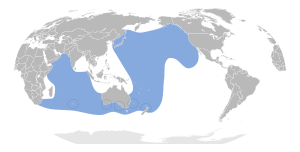Flesh-footed shearwater facts for kids
Quick facts for kids Flesh-footed shearwater |
|
|---|---|
 |
|
| Conservation status | |
| Scientific classification | |
| Genus: |
Ardenna
|
| Species: |
carneipes
|
 |
|
The flesh-footed shearwater (Ardenna carneipes) is a medium-sized shearwater bird. It has black feathers all over its body. You can spot it by its light pink feet and a pale beak with a clear black tip.
This bird is part of a special group called Hemipuffinus. It is closely related to the pink-footed shearwater, which also has a light-colored beak. Scientists once thought these birds were in the Puffinus group, but now they are in the Ardenna group.
Contents
About the Flesh-footed Shearwater
Recent studies looking at the genes of these birds show that flesh-footed shearwaters living in the Pacific Ocean are quite different from those in Australia. This might be because they stay close to where they were born and find food in different ways during breeding season.
Family Tree and Relatives
A study in 2021 found that the flesh-footed shearwater and the pink-footed shearwater (Ardenna creatopus) are very similar genetically. This means they might even be considered the same species, or very close relatives!
Where They Live and Breed
Flesh-footed shearwaters live and breed in large groups called colonies. They have two main areas where they raise their young:
- One area is in the southwest Pacific Ocean. This includes Lord Howe Island (with over 22,000 pairs), South Australia (about 1,800 pairs), and northern New Zealand (around 13,000 pairs).
- The other main group lives along the coast of Western Australia. About 36,000 pairs breed on 42 different islands there.
- Another 500 pairs live on St Paul Island in the Indian Ocean.
Sadly, the number of these birds is going down in many places. Because of this, they are now considered "near threatened" in Australia and "vulnerable" in New Zealand.
Challenges and Threats
These shearwaters travel to the North Pacific Ocean during the summer. While there, many birds are accidentally caught in fishing nets. This is called "bycatch."
They also face problems from climate change, which affects their environment. Another big issue is "heavy metal contamination." Scientists think this happens because the birds eat a lot of plastic floating in the ocean. They mistake the plastic for food, and the plastic can contain harmful metals.
See also
 In Spanish: Pardela paticlara para niños
In Spanish: Pardela paticlara para niños



